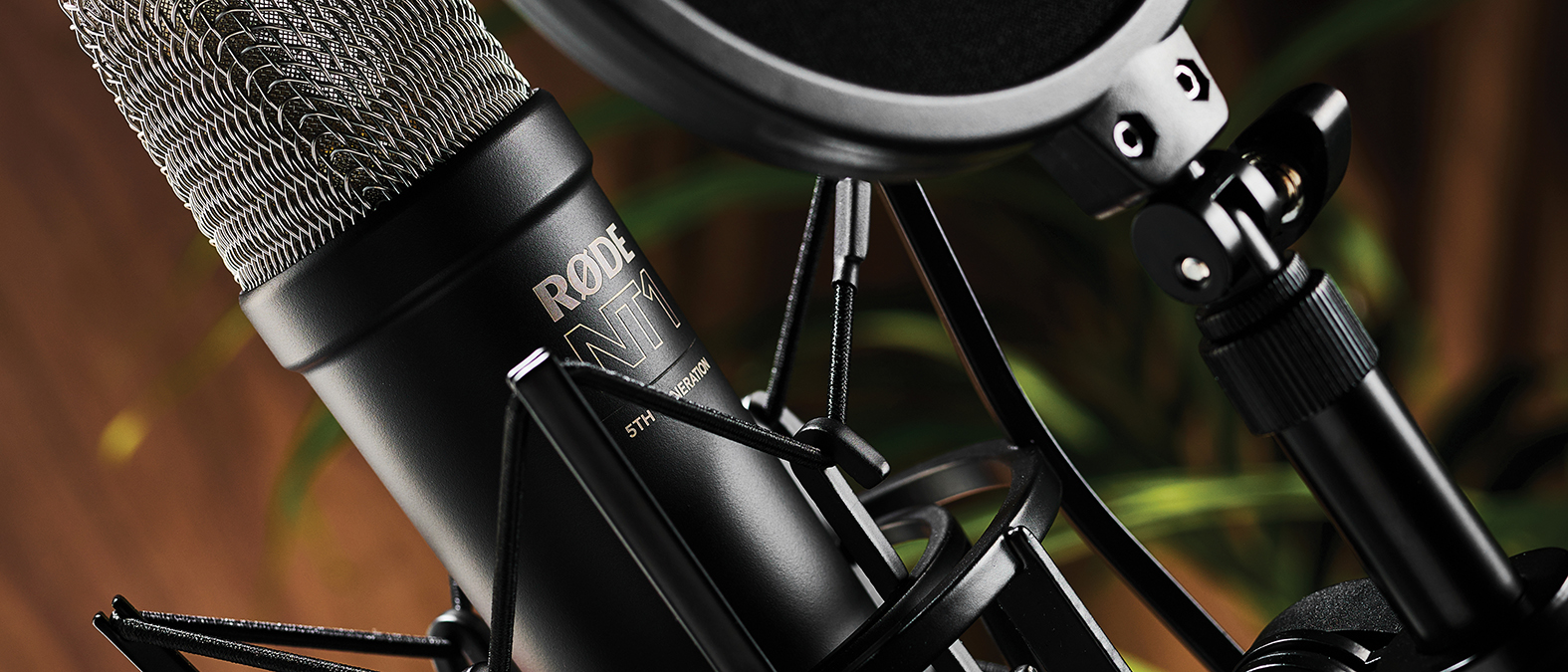MusicRadar Verdict
With integrated USB interfacing, 32-bit float support and impressive noise figures the latest NT1 delivers a fully featured upgrade on its predecessors and continues to be an excellent budget choice
Pros
- +
Box includes everything you need to get started.
- +
Integrated USB interface with 32-bit float option.
- +
Clever dual-purpose XLR / USB connector.
- +
Very low self-noise.
Cons
- -
Integrated USB interface doesn't support 44.1kHz sample rate.
- -
Integrated USB interface has no minimal latency monitoring facility
MusicRadar's got your back
Røde Microphones NT1 5th gen: What is it?
Røde’s NT1 is one the most popular affordable large capsule cardioid condenser microphones available and this 5th generation model is its most innovative yet.
The bundle provides everything you need to get started. In addition to the mic (available in either black or grey), you get a suspension cradle with an integrated pop shield holder, a pop shield, a storage bag, a 7m XLR cable and a 3-metre USB-C to USB-C cable.
That last aspect is significant as the NT1 now incorporates USB interfacing, so you can connect it to your computer without an additional audio interface.
The mic uses the same 1” gold-sputtered HF6 capsule as its predecessor, although powering is now 48V (not 24 or 48V) or 5V via the new USB connection. Output sensitivity (25mV/Pa) is lower than before, while self-noise is slightly improved (4dB A-weighted).
The integrated USB interfacing uses a cleverly designed dual-connect XLR / USB-C socket which is much slicker than a body-side USB socket.
There are no on-body controls, but the mic is plug-and-play so applying gain to the onboard Revolution preamp may be available directly in your DAW. To access NT1’s further features you install Rode Central (Mac, PC, iOS, Android).
Gain (0 to 60dB) is joined by Aphex-powered effects including a high pass filter (75 or 150Hz), compressor, noise gate, Aural Exciter and Big Bottom.
Want all the hottest music and gear news, reviews, deals, features and more, direct to your inbox? Sign up here.
The A/D interface delivers impressive specs, with high sample rates (48, 96 and 192kHz) coupled with 24-bit and 32-bit float functionality. This means if your DAW can record audio at 32-bit float, and assuming you don’t exceed the capsule’s maximum SPL, it’s not possible to clip your audio.

Røde Microphones NT1 5th gen: Performance and verdict
As we’ve come to expect from Rode, the build quality is excellent, and although slightly lighter than the previous version, the Aussie-built mic feels great and sports the classic NT1 shape and capsule grille.
There’s no flight case, but once you’ve dispensed with the individual packaging all the bits can fit in the main box. The cradle with integrated pop shield mount and shield is very handy, and the shield itself is a decent 2-layer design.
One slight frustration is the shield can only sit opposite the mic stand elbow and not to the side.
In practice, we found the USB interfacing worked seamlessly and once set up for 32-bit use, we could clip the recording and then use the file gain in my DAW to restore the unclipped waveform.
Alas, one downside is 32-bit mode disables all the onboard processing. There’s also no 44.1kHz option and no minimal latency monitoring.
The NT1 as expected delivers a reasonably neutral response with a slight lift in the upper frequencies. There’s a noticeable proximity starting from about 10cm, and the mic handles plosives very well from about 20cm and beyond.
The polar pattern isn’t too tight and the rear rejection is quite good. Sonically, it’s not the most exciting mic we’ve used but it’s neutral enough for a wide variety of applications and as noted is very quiet.
If a product reaches its 5th generation then the manufacturer is clearly doing something right. Røde’s NT1 is one such design and this latest version definitely keeps things moving forward.
MusicRadar verdict: With integrated USB interfacing, 32-bit float support and impressive noise figures the latest NT1 delivers a fully featured upgrade on its predecessors and continues to be an excellent budget choice.
Røde Microphones NT1 5th gen: The web says
"RØDE’s NT1 5th Generation is a wonderful and remarkable product. It remains the class-leading, affordable large diaphragm condenser microphone it has been for three decades, yet now incorporates USB and DSP smarts that make straight-to-DAW recording pain-free."
MusicTech
"Unlike many USB mics, the NT1 5th Gen is an input‑only device, and doesn’t have a headphone output of its own. Nor does it have a physical gain control. As we’ll see, this isn’t necessarily an issue, and for spur‑of‑the‑moment recordings where you don’t need to monitor anything, you could just plug in and go."
Sound On Sound
Røde Microphones NT1 5th gen: Hands-on demos
Røde Microphones
Podcastage
Dark Corner Studios
Røde Microphones NT1 5th gen: Specifications
- Capsule: 1” true condenser
- Pickup Pattern: Cardioid
- Frequency Range: 20Hz - 20kHz
- Output Impedance: 100Ω
- Maximum SPL: 142 dB SPL
- Equivalent Noise (A-weighted): 4dBA
- Sensitivity: 25mV @ 94dB SPL (+/- 2 dB @ 1 kHz)
- Power: 48V phantom or 5V USB
- Connection: XLR or USB-C
- Finish: Black or Grey
- Interface: 48, 96, 192kHz, 24-bit / 32-bit float
- Onboard processing: HPF, compressor, gate, Aphex exciter and Big Bottom
- Size: 52(diameter) x 189(height) mm
- Weight: 308g
- CONTACT: Røde Microphones
Jon is a London based platinum award winning mixer, producer, composer and club remixer with a diverse CV that spans dance, pop, rock and music for media. He’s also a long term contributor to MusicRadar's music technology tutorials and reviews. Whether working alone or collaborating he usually handles final mixdowns, so you’ll also find MusicRadar peppered with his handy mixing tips.

